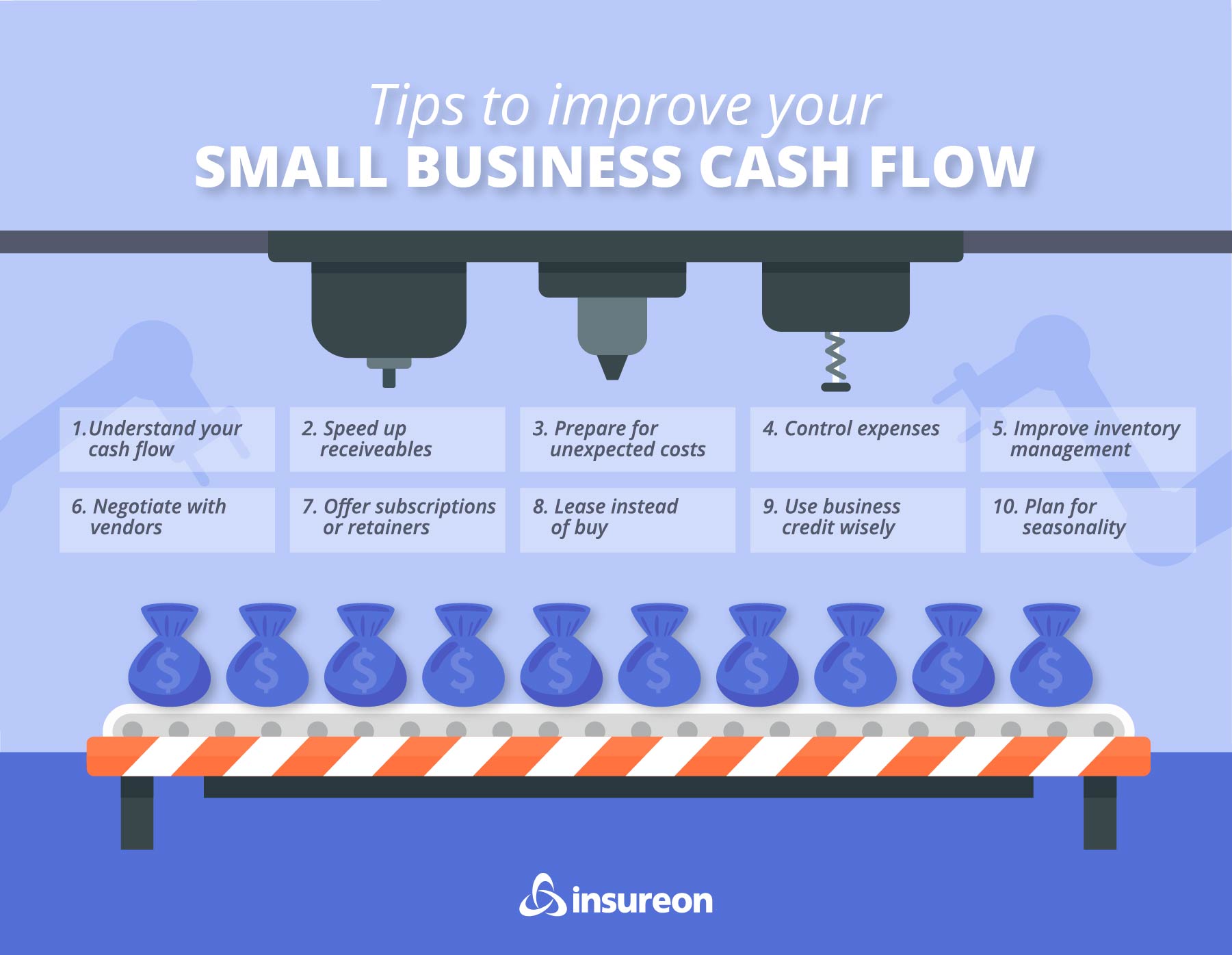How to improve cash flow in your small business

As a small business owner, you likely deal with late payments, unexpected expenses, or seasonal sales fluctuations. These challenges aren’t just frustrating. If you don’t have sufficient operating capital, you may not be able to cover your expenses, which could force your business into bankruptcy or closure.
Improving your cash flow gives your business the financial stability it needs to weather slow times and take advantage of growth opportunities. Let’s take a look at some strategies you can use to strengthen your cash flow to position your business for long-term success.
Understand your cash flow
Many business owners confuse cash flow with profit, but they aren't the same. Understanding the difference is essential when determining how to improve a company's cash flow. Profit is the money left over after subtracting expenses from revenue. Cash flow, on the other hand, is the money moving in and out of your business. A business can be profitable and struggle with a cash flow issue at the same time.
Tracking cash flow is easy with modern systems. Bookkeeping software, such as QuickBooks, Xero, FreshBooks, and Wave, provides a clear picture of the amount of cash on hand you have and your receivables. They allow you to automate the generation of cash flow statements with just a few mouse clicks, so you can quickly see whether you can cover upcoming expenses.
Setting aside time each month to analyze your cash flow and monitor cash flow KPIs helps you identify opportunities to make informed decisions. For example, it may help you see if your inventory is sitting too long or if you’re paying your bills earlier than necessary.
When reviewing your cash flow statements, some important KPIs to monitor include:
- Days sales outstanding (how quickly customers pay you)
- Inventory turnover rate (how fast inventory moves)
- Burn rate (how quickly you're using available cash)
- Operating cash flow ratio (your ability to cover short-term liabilities)
Keeping an eye on these indicators helps you spot potential cash flow problems early. It gives you time to address them before they turn into bigger problems.

What is good cash flow for a business?
To increase cash flow in a business, you need to determine the operating capital your business requires without drawing on your reserves or relying on credit. Most financial experts recommend keeping enough cash on hand to cover three to six months of expenses. However, the cash position that’s right for your business depends on:
- The type of business
- How long your business has been operating
- Your growth plans
- How easily you can obtain financing
Speed up receivables
One of the most effective ways to improve business cash flow is to streamline your accounts receivable cash inflows. You can do this by sending invoices immediately instead of sending them weekly or monthly in batches. Also, consider shortening your payment terms from a due date of 30 days to 15 days. Just be sure to communicate the change professionally and with advance notice.
Another strategy is to offer discounts for faster customer payments. For example, you could offer a 2% discount when customers pay invoices within 10 days. It's also important to accept multiple digital payment methods, like mobile payment apps and online payments. The easier it is for customers to pay, the more likely they are to pay on time.

Protect your business from unexpected costs
Even with excellent cash flow, an unexpected event could quickly drain your business's reserves. If a customer slips and falls in your store, your business would likely be liable for significant medical bills and legal fees. However, the right insurance coverage can protect your business from costly liabilities.
Policies your business may need include:
General liability
General liability insurance is typically the foundation of a business's risk management strategy. It covers third-party bodily injury, property damage, and related legal costs.
Business owner’s policy
A business owner’s policy (BOP) bundles three types of policies: general liability, commercial property, and business interruption. The bundle is typically less expensive than purchasing each policy separately.
Professional liability
Professional liability insurance is also known as errors and omissions (E&O) insurance. It covers your business if a client claims you made a mistake, were negligent, or failed to deliver the services you promised.
Workers’ compensation
Workers’ compensation insurance is required by law in most states. It covers work-related employee injuries and illnesses.
Commercial auto
Commercial auto insurance covers vehicles used for business purposes. It typically includes liability coverage for injuries or property damage caused to others, collision coverage for damage to your business vehicle, and comprehensive coverage for theft, vandalism, or weather-related damage.
Commercial property
Commercial property insurance protects your physical business assets and your fixed business location—including the building, equipment, inventory, and furniture—from losses caused by fire, theft, vandalism, and certain natural disasters.
Business interruption
Business interruption insurance is also known as business income coverage. It covers the loss of business income after a fire, storm, or other property damage.
Control your expenses
A crucial step in enhancing a business's cash flow is effectively managing its operating costs. You can do that by regularly reviewing your fixed and variable costs. This may help you identify services you rarely use or expenses that have gradually increased over time. You may also find non-essential expenses you can cut, like software subscriptions, frequent business travel that can be replaced with virtual meetings, or office space that exceeds your current needs.
Having the right-sized insurance can reduce your business’s financial risk without overpaying. If you’re underinsured, it could leave you vulnerable to significant liabilities. Ideally, you should optimize your coverage to make sure you’re fully covered for potential risks while controlling your costs.
Improve inventory management
The longer your inventory sits on shelves, the longer your working capital is tied up. You can increase cash flow in a business by analyzing your sales data to identify which products move quickly and which ones don't. This helps you avoid overstocking to free up cash.
Inventory tracking software can be used to simplify inventory management. You can set up alerts to notify you when you run low and track which products sell the fastest to prevent unnecessary purchases. Additionally, consider implementing just-in-time (JIT) inventory practices, which involve purchasing inventory as needed. This strategy reduces your storage costs and minimizes the cash you have tied up in unsold merchandise.

Insuring your small business doesn't have to cost a fortune. At Insureon, we help you find affordable coverage that meets the unique needs of your small business, through a single online application. That way you can get peace of mind without breaking the bank.
Negotiate with vendors
Consider asking for better terms from your vendors to delay your accounts payable. Many suppliers are willing to extend the standard invoice payment term of 30 days to 60 days if you’ve worked with them for a few years and you have a good payment history.
Also, be sure to ask your suppliers if they’ll give you a discount for bulk or early payments. Many will be willing to give you a modest early payment discount if you pay in 10 days instead of 30 because it helps their cash flow. You may also qualify for volume pricing if you consolidate orders into larger purchases.
The marketplace is constantly changing, and new suppliers may offer better terms or prices. It might be worth your time to shop around to see if you can save. Switching suppliers may help you reduce your costs to improve your profit margins and free up cash.
Offer subscriptions or retainers
Creating steady, predictable revenue streams is another way to improve your business’s cash flow. You can do this by shifting from one-time transactions to offering subscriptions. This way, you know how much revenue your business can expect each month. Eliminating the guesswork makes managing cash flow easier. It simplifies budgeting and planning, which makes it easier to take advantage of growth opportunities.
Value-added packages can be used to generate recurring income. Many customers perceive bundled services as being better value than purchasing services separately. For example, a graphic designer might offer a monthly retainer that includes a certain number of design hours, stock photo access, and a consultation.
This model works well for service-based businesses, like commercial and residential cleaning businesses, IT support companies, and consulting services. With a little creativity, businesses that sell products can also offer subscriptions. For example, a bakery might offer a "pastry of the month" subscription.
Lease instead of buy
Large purchases can strain your finances if you have to pay for them all at once. You may be able to improve your cash flow by leasing equipment, vehicles, office space, and other essentials instead of buying them. Many lease arrangements are flexible and allow you to upgrade when newer models come out.
This can give you a competitive edge. For example, you can quickly upgrade when new equipment comes out. If competitors own their equipment, they may have to sell what they have before they can purchase new equipment.
Be sure to evaluate the long-term costs and cash flow benefits before signing a lease agreement to make sure it makes sense for your business. Although leasing can help your cash flow, you'll typically pay more over the life of the lease than if you purchase something upfront.
Use business credit wisely
A business line of credit can be used as a buffer, so you don't have to dip into your cash reserve. It allows you to access funds for operating expenses during slow seasons or pay for unexpected expenses. An important benefit of a line of credit is you only pay interest on what you borrow, instead of on the full credit limit. This makes it an affordable way to get the money you need.
Be sure to manage your existing debt carefully to prevent interest from piling up. Credit cards can be used for minor expenses, but the interest compounds daily. If credit card debt builds up, consider taking out a debt consolidation loan. These loans have fixed interest rates that are typically lower than the rates for credit cards.
Also, if you need financing, be sure to compare your options to find a loan with the lowest fees and interest rates. The difference between a 10% and 14% interest rate might not seem like much, but over time, it can add up to thousands of dollars in extra costs.
Even with excellent cash flow, an unexpected event could quickly drain your business's reserves.
Plan for seasonality
To help you plan for business fluctuations, consider building a cash reserve during your peak season when your cash flow is strongest. A good rule of thumb is to save enough to cover at least three months of operating expenses. This helps you make it through the slow season without taking on debt.
Slow seasons are predictable for most businesses. By analyzing past performance data, forecasting can help you predict how much you’ll need for your next slow period. When it arrives, you can delay optional expenses and inventory purchases. You can also focus your marketing efforts on the products or services that perform well during these periods.
Also, consider using flexible staffing or outsourcing to control payroll costs. You could use contractors or freelancers for specialized tasks or seasonal staff to save on overhead. Online platforms make it very easy to find qualified temporary help.
Get the right insurance coverage with Insureon
It's easy to get insurance for your small business with Insureon. Just fill out our online application to receive quotes from trusted providers. Our expert insurance agents are available to answer any questions and help you find the best small business insurance for your needs.
Most small business owners can get same-day coverage and easily download a certificate of liability insurance as soon as they purchase a policy.
Cyrus Vanover, Contributing Writer
Cyrus is a finance and insurance writer who is passionate about helping people and businesses succeed. He is also the author of the book "Earn a Debt-Free College Degree." He has written for some of the largest financial institutions in the country including TD Bank, Citizens Bank, and many credit unions. Cyrus has also contributed to Newsweek. Based in the Blue Ridge Mountains of Virginia, he enjoys hiking the local trails and exploring old Civil War battlefields and other historical sites in his spare time.









